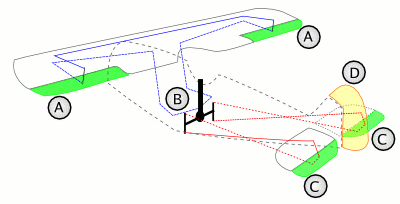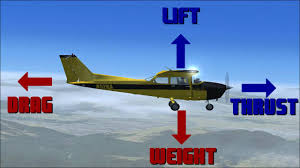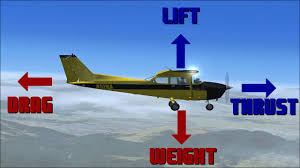|
PRIMARY FLIGHT CONTROLS
Aircraft primarily controls itself by using its primary flight controls. These are
Aerodynamic Forces
When two solid objects interact in a mechanical process, forces are transmitted, or applied, at the point of contact. But when a solid object interacts with a fluid, things are more difficult to describe because the fluid can change its shape. For a solid body immersed in a fluid, the "point of contact" is every point on the surface of the body. The fluid can flow around the body and maintain physical contact at all points. The transmission, or application, of mechanical forces between a solid body and a fluid occurs at every point on the surface of the body. And the transmission occurs through the fluid pressure. Definitions of Lift and Drag Since the fluid is in motion, we can define a flow direction along the motion. The component of the net force perpendicular (or normal) to the flow direction is called the lift; the component of the net force along the flow direction is called the drag. These are definitions. In reality, there is a single, net, integrated force caused by the pressure variations along a body. This aerodynamic force acts through the average location of the pressure variation which is called the center of pressure Aircraft's Rotations An aircraft in flight is free to rotate in three dimensions. It is necessary to control the attitude or orientation of a flying aircraft in all three dimensions. In flight, any aircraft will rotate about its center of gravity, a point which is the average location of the mass of the aircraft. We can define a three dimensional coordinate system through the center of gravity with each axis of this coordinate system perpendicular to the other two axes. We can then define the orientation of the aircraft by the amount of rotation of the parts of the aircraft along these principal axes. YAW
The yaw axis is defined to be perpendicular to the plane of the wings with its origin at the center of gravity and directed towards the bottom of the aircraft. A yaw motion is a movement of the nose of the aircraft from side to side. A positive yaw, or heading angle, moves the nose to the right. The rudder is the primary control of yaw. PITCH The pitch axis is perpendicular to the yaw axis and is parallel to the plane of the wings with its origin at the center of gravity and directed towards the right wing tip. A pitch motion is an up or down movement of the nose of the aircraft. A positive pitch angle raises the nose and lowers the tail. The elevators are the primary control of pitch. ROLL The roll axis is perpendicular to the other two axes with its origin at the center of gravity, and is directed towards the nose of the aircraft. A rolling motion is an up and down movement of the wing tips of the aircraft. The angular displacement about this axis is called bank. The pilot changes bank angle by increasing the lift on one wing and decreasing it on the other. A positive roll angle lifts the left wing and lowers the right wing. The ailerons are the primary control of bank. The rudder also has a secondary effect on bank. In flight, the control surfaces of an aircraft produce aerodynamic forces. These forces are applied at the center of pressure of the control surfaces which are some distance from the aircraft cg and produce torques (or moments) about the principal axes. The torques causes the aircraft to rotate. The ability to vary the amount of the force and the moment allows the pilot to maneuver or to trim the aircraft BASICS OF AERODYNAMICS Aerodynamics is the study of forces and the resulting motion of objects through the air. Anything that moves through air reacts to aerodynamics. Here we only discussing about aircraft's aerodynamics. FOUR forces of flight
A force may be thought of as a push or pull in a specific direction. A force is a vector quantity so a force has both a magnitude and a direction. When describing forces, we have to specify both the magnitude and the direction. |
AuthorPalash Choudhari Archives
June 2021
Categories
All
|




 RSS Feed
RSS Feed
